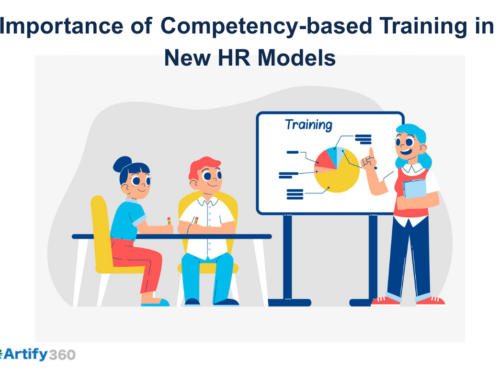In the rapidly evolving modern business, every decision matters, and human resource management plays a pivotal role in steering an organization in Saudi toward success. The key to effective HR management lies in data-driven decision-making. This journey through data begins with understanding the importance of strategic HR metrics and their transformation into actionable insights.
By integrating strategic HR metrics into Saudi HR software, businesses can unlock a treasure trove of information that shapes smarter, more impactful HR strategies. In this article, let’s delve into the role of the HR system in analyzing strategic HR metrics and how it translates data into actionable insights for HR managers.
Role of HR metrics in business success
Metrics, in essence, are measurable indicators that provide valuable information. In HR, metrics act as the compass guiding workforce management. These quantifiable measurements offer a bird’s-eye view of various HR functions, enabling us to see beyond the surface and make informed decisions based on actual data. From recruitment and performance evaluation to employee engagement and retention, metrics illuminate the path to excellence.
Strategic HR metrics elevate the concept of metrics to a higher level. These metrics are carefully chosen and aligned with an organization’s overarching goals. They bridge HR activities and the bigger picture of business success. In other words, strategic HR metrics act as a powerful translator, converting raw data into actionable insights that directly contribute to an organization’s objectives.
Integrating strategic HR metrics in HR software
Enter Saudi’s top HR software, a multifaceted solution designed to streamline HR processes and amplify their impact. By integrating strategic HR metrics into this software, businesses create a centralized hub where data is collected, analyzed, and transformed into actionable insights. This integration marks a significant step in how HR professionals leverage data to make strategic decisions that drive organizational growth.
Defining Key Performance Indicators (KPIs)
Key Performance Indicators, or KPIs, are the backbone of strategic HR metrics. They are the specific metrics that matter most in assessing performance and progress. HR software in Saudi allows organizations to define and track these KPIs, ensuring a clear line of sight toward their strategic objectives.
Whether measuring turnover rates, recruitment efficiency, or employee engagement levels, the HR system simplifies identifying and monitoring KPIs.
Linking metrics to organizational objectives
The true power of strategic HR metrics lies in their alignment with organizational goals. By selecting metrics that directly contribute to these goals, HR professionals ensure that their efforts are data-driven and purposeful. HR tools aid in this process by providing a framework to identify, track, and measure metrics that have a tangible impact on business success.
Data collection and analytics
Behind every strategic HR metric is a wealth of data waiting to be harnessed. HR solutions play a crucial role in data collection and analysis. It is a reliable repository where data is stored, organized, and transformed into meaningful insights. HR software in Saudi transforms raw data into visual representations through sophisticated analytics tools, making it easier to understand trends and patterns.
Turnover and retention metrics
High turnover rates can hinder organizational growth. Strategic HR metrics focused on turnover and retention shed light on the effectiveness of talent retention strategies. The HR system monitors turnover rates, enabling HR professionals to identify red flags and take proactive measures. By understanding why employees leave and why others stay, organizations can fine-tune their HR strategies for better retention.
Recruitment metrics
The lifeblood of any organization lies in its ability to attract top-tier talent. Recruitment metrics offer a glimpse into the efficiency of talent acquisition efforts. Saudi HR software transforms recruitment data into insightful metrics, allowing HR teams to assess the time it takes to hire a candidate, the quality of the candidates attracted, and the overall effectiveness of recruitment campaigns.
Performance metrics
A well-functioning workforce is one where employee contributions align with business objectives. Performance metrics delve into the heart of employee output and growth. HR tools enable organizations to monitor individual and team performance, track goal achievements, and identify skill development needs. These metrics illuminate areas of excellence and opportunities for improvement.
Employee engagement metrics
Engaged employees are the driving force behind a thriving organization. Employee engagement metrics offer insights into employees’ connection with their work and the company. HR tools facilitate the collection of engagement data through surveys, feedback mechanisms, and sentiment analysis. These metrics provide a valuable glimpse into the workforce’s satisfaction and commitment.
Analytics and insights
Data without interpretation is like a puzzle missing its final piece. Strategic HR metrics, when analyzed, unveil insights that guide decision-making. HR solutions empower HR professionals with the tools to generate reports, visualizations, and dashboards that translate data into understandable insights. These insights become the compass guiding strategic actions.
Final thoughts
In modern HR management, data is the partner that leads to success. When embraced and integrated with Artify360 HR software, strategic HR metrics elevate HR’s role from mere administration to a strategic driving force.
In conclusion, the path to organizational excellence is illuminated by the insights derived from these metrics. By harnessing the power of Artify360 HR software, businesses can confidently make decisions that propel them toward a future of growth and success.






